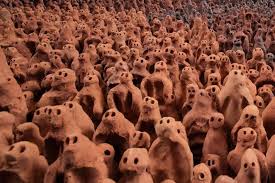Terracotta Journey
- Carol Anne Jones

- Oct 11, 2020
- 4 min read

I remember feeling overwhelmed as I walked into the exhibition hall. Suddenly I faced 35,000 figures and double the number of little eyes staring up at me; me now a giant. I couldn’t help but look away, intimidated, only to look once again at the sea of little faces, then bracing myself for a Rockstar ego rush before the audience. I marked my visit to Antony Gormley’s Field installation at TATE Liverpool, as a major experience.
Antony created a few ‘Field’ experiences in collaboration with communities from across the globe. The one I saw was an American version, made in 1990 with the Texca family of brick-makers in San Matias, Mexico. These little figures ranged from between 8 to 26 centimeters tall, comprising 25 tonnes of clay.
He graduated from Trinity College, Cambridge, after studying archaeology, anthropology and art history. His work direction lies in these foundations, he uses the human form to explore man’s existence in and relation to the world. Later his Blind Light installation had 287 life size figures created and each fashioned after a real person, people from the British cities of Newcastle and Gateshead, with an age range of 2 to 85. The concept itself is similar to the Terracotta Warriors, where the image of every warrior is individualised.
After seeing Fields, I formed this connection with Gormley’s work and the Terracotta Warriors and always wanted to go see them. Little did I know at the time I’d eventually work in China. Last week the opportunity arose to travel to Xi’an. With Covid-19 under control in China, I took a flight from Beijing despite it being Golden week, a major holiday in China, with enormous crowds due to file into many of the attractions around the country.
Xi’an has been at the crossroads between East and West from a geographic, spiritual and culinary sense since its founding more than two millennia ago. During the Tang Dynasty it was one of the most important cities in the world, the capital of China, a terminus of the Silk Road, with everything passing through on its journey from China to the West, and vice versa. I found a city that had clean air, lots of trees and welcoming people towards foreigners.
The following day after arrival, we took a tour to the Terracotta Warriors. The story is that in 1974 a group of workers digging wells, unearthed fragments of a clay figure, the first sighting of what would become one of greatest archaeological discoveries of recent times. The diggers notified Chinese authorities, who dispatched government archaeologists to the site. There are still underground vaults largely unexcavated, across a 22 square mile area. Some are hard to get to, but three major pits are easily accessible, now enclosed inside the four acre Museum of the Terracotta Army.
We entered warehouse 1 and saw long columns of reassembled warriors, from broken pieces, standing in formation. Each warrior wears an armored vest, cap, goatees; the fashion of the time, and yes, each warrior exhibits an astonishing individuality. There was a bit of a tourist stampede, less so in warehouse 2, which shows how the figures appeared when they were found: some stand upright, buried to their shoulders in soil, while others lie toppled on their backs, alongside fallen and cracked clay horses. Warehouse 3 is similar.
The Terracotta Warriors are part of an elaborate mausoleum created to accompany the first emperor of China into the afterlife, according to archaeologists.
The story of Qin Shi Huang, the Emperor, is a long, filled with ambiguities. The then Ying Zheng took the throne in 246 B.C. at the age of 13. By 221 B.C. he had unified a collection of warring kingdoms and took the name of Qin Shi Huang Di, the First Emperor of Qin. He achieved a lot during his rule and is credited for building the first version of the Great Wall. He ordered the mausoleum's construction shortly after taking the throne with more than 700,000 laborers working on the project. A mass production approach was decreed. Artisans turned out figures abit like cars on an assembly line. Clay lends itself to quick and cheap fabrication. Workers built bodies, then customized them with heads, hats, shoes, mustaches, ears etc., made in small molds. Some of the figures appear so strikingly individual they seem modelled on real people, but this is unlikely according to the curator of the visiting Terracotta Warrior exhibtion in 2007 at the British Museum; they could have been told that you need to represent all the different types of people who come from different regions of China.
The project was halted in 209 B.C. amid uprisings a year after Qin's death. For archaeologists, one indicator of a sudden happening was the extensive damage inflicted on the Terracotta Army. It is said, marauding forces raided the pits where clay soldiers stood guard and plundered their real weapons. The emperor's tomb lies beneath a forested hill about a half mile from the museum. Out of reverence for an imperial resting place and concerns about preserving what might be unearthed there, the site hasn't been excavated. The mysteries that surround his life will likely never be completely resolved. However, my terracotta ambition is, I feel I’ve come full circle from Fields to seeing the Terracotta Warriors, both experiences have been exhilarating, amazing sights that I’ll never forget.






Comments